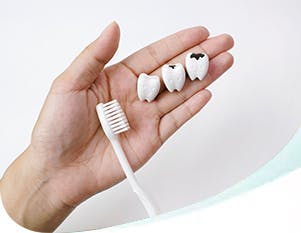How Does the Color of Dentin Affect Tooth Color?
If you’re concerned about the color or perceived discoloration of your teeth, it may be helpful to learn about the different layers of your teeth, what they do, and how they contribute to tooth color. One of these layers is called dentin. Its role in the structure of your teeth may affect how your teeth look.
What is Dentin
Your teeth are made up of four different kinds of tissues that each serve a specific purpose.
On the outside above the gumline is the enamel. Made of calcified tissue that doesn’t contain any living cells, it is an incredibly hard surface, even stronger than bone.1,3 The tissue on the outside of your tooth below the gumline is called cementum.1 This covers the root of the tooth and unlike the enamel, it does contain living cells.1 The pulp is the soft center of the tooth that contains nerves, blood vessels and connective tissues.1
The final dental tissue that makes up your tooth is called dentin. This is the middle layer of the tooth, below the enamel and cementum and surrounding the pulp.1 The primary role of dentin is to provide support for the enamel, protect the pulp, and transmit impulses between the enamel or root and the pulp.2 This layer contains living tissue full of microscopic tubules, which can lead to sensitivity if exposed to extreme temperatures or certain kinds of sugary, starchy, or sour foods.3 This exposure would be due to a loss of enamel either due to trauma or demineralization.2
What Color is Dentin and How Does That Affect Your Teeth?
In normal, healthy teeth, the tubules within the dentin cause it to have a yellowish hue.2,4 For those with a specific genetic abnormality, the dentin tubules can be wider than normal, changing the color of the dentin and causing it to look more blue or gray in color.2
Despite its strength and durability, the enamel of your teeth is somewhat translucent and can vary from grey to white, yellow or anything in between.3 This translucency means that the enamel is not wholly responsible for the appearance of your teeth, or the color they’re perceived to be. Instead, the dentin is primarily responsible for tooth color and can cause your teeth to appear to fit into the range of colors between gray and yellow.3 In fact, enamel and dentin together give your teeth their unique color.
If the color of your teeth is looking a little more yellow than normal, you may want to talk to a dentist about what’s happening. If the enamel of your teeth has demineralized or experienced enamel erosion, it may be more translucent than you’d expect it to be, allowing the yellow dentin to show more clearly.1,3 However, if your enamel is compromised, you may experience sensitivity to extreme temperatures and overly starchy, sour, or sweet foods. The dentin in your teeth has a lower mineral content than the enamel, which means it erodes more quickly.2 So if tooth decay is not treated, it can affect multiple layers of your teeth in quick succession. If you’re not feeling any pain in your teeth, discoloration, or yellowing of enamel can tip you off that something might be wrong.
Since the enamel of your teeth cannot naturally repair itself, your dentist may come up with a plan for remineralization. The dentin in your teeth has a lower mineral content than the enamel, which means it erodes more quickly.2 So if tooth decay is not treated, it can affect multiple layers of your teeth in quick succession. If you’re not feeling any pain in your teeth, discoloration, or yellowing of enamel can tip you off that something might be wrong. Since the enamel of your teeth cannot naturally repair itself, your dentist may come up with a plan for remineralization.
*with twice daily brushing




